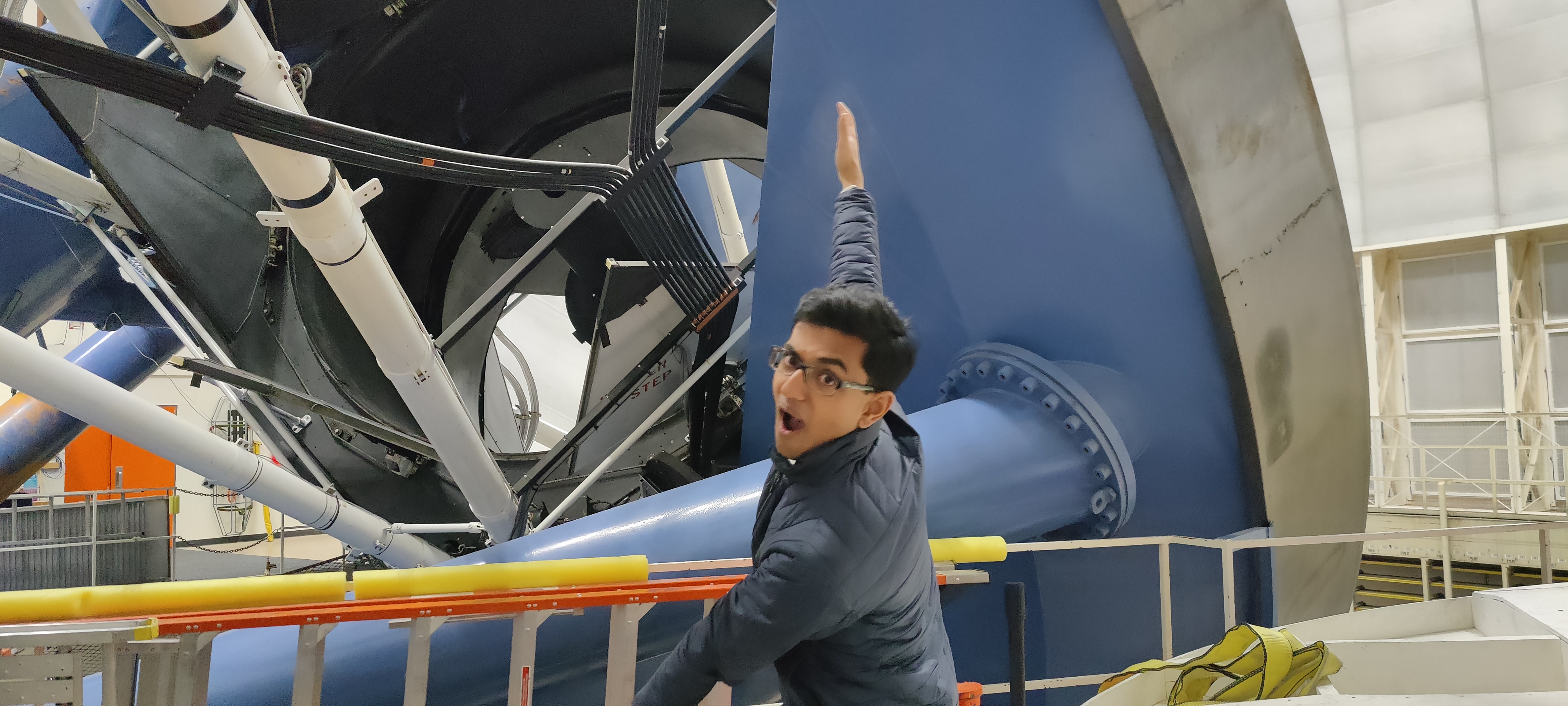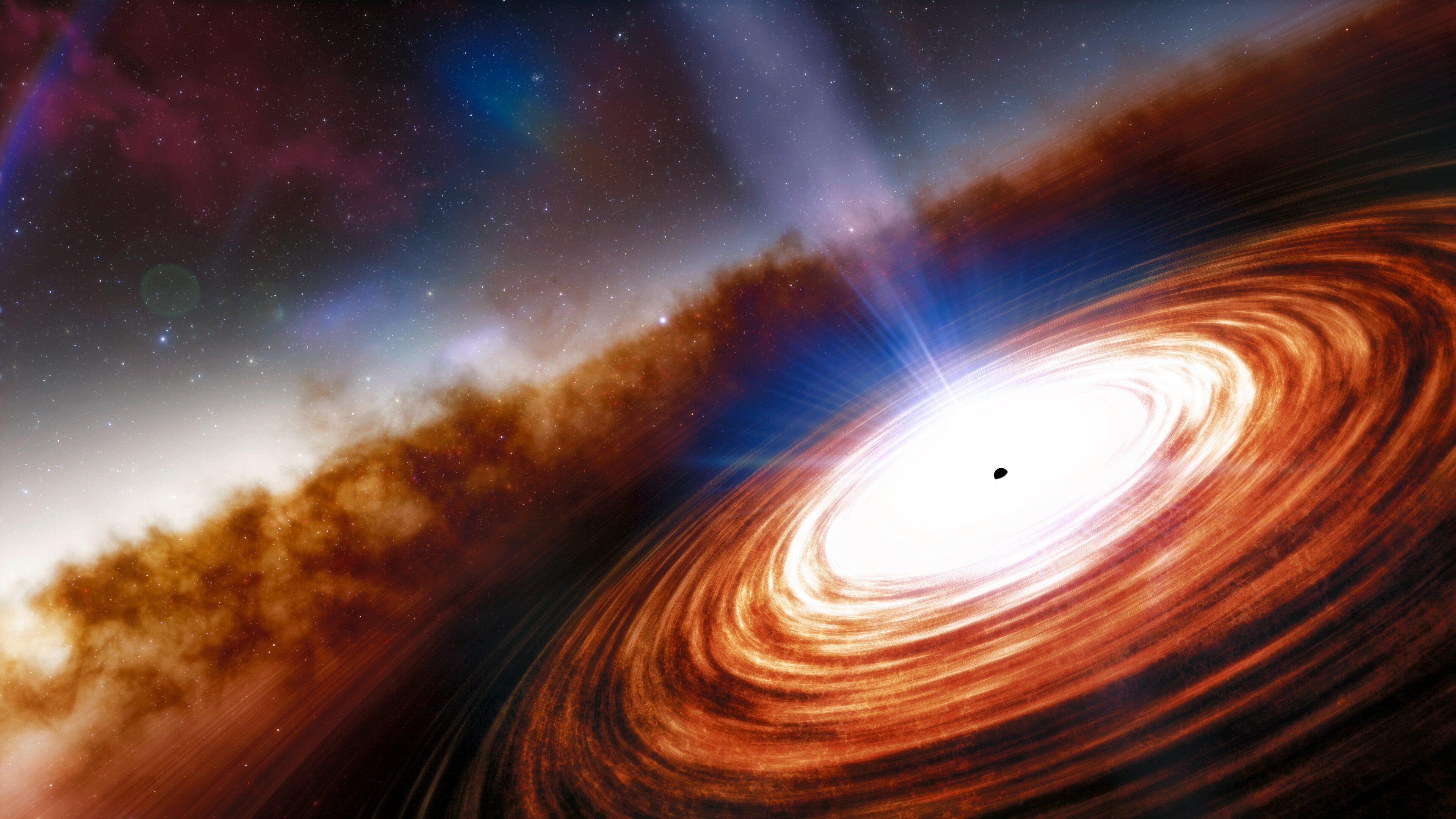Research
I’m using an extremely powerful telescope called JWST to study distant galaxies and black holes. Most galaxies have a “supermassive” black hole at their center, which can be billions of times heavier than the Sun. We know roughly when the first black holes should have formed, and how quickly they ought to have grown, so we can calculate how big they should be. However, JWST has found many black holes that are way more massive than we expected. I hope to explore this mystery over the course of my graduate studies.
But how can we even “see” a black hole if they’re supposed to be completely dark? Although we can’t see the black holes themselves, we can often see the things around them. In particular, I look at objects called “quasars”. A quasar is a massive black hole surrounded by a disk of gas. Particles in the disk crash into each other, heating up due to friction. The disk gets so hot that it begins to glow, sometimes outshining its entire host galaxy which can have trillions of stars! These cosmic monsters are fascinating for many reasons. Quasars are so bright that they can be seen at huge distances, allowing astronomers to catch glimpses of conditions in the early Universe. They also give us information about how black holes and galaxies grow together and evolve over time.
As an undergraduate student at the Universtity of Arizona, I worked with Xiaohui Fan and Jinyi Yang. Using the Dark Energy Spectroscopic Instrument (DESI), I identified quasars at z > 4.5 through visual inspection and spectral analysis. This project is described in detail in the publication Yang, Jinyi; Fan, Xiaohui; Gupta, Ansh et al., 2023, Submitted, DESI z > 5 Quasar Survey. I. A First Sample of 400 New Quasars at z ~ 4.7 - 6.6.. I’m also investigating the quasar correlation function, a measure of how “clustered” these objects are at different points in time.

In the summer of 2023, I took part in an REU at the University of Kansas working with Allison Kirkpatrick on ionization conditions in JWST CEERS galaxies. About 400,000 years after the big bang, the hot, dense plasma that filled the universe settled into an ocean of neutral hydrogen gas. This caused all of space to become transparent, freeing light that had been trapped in an opaque sea of particles for millenia. Without this phase transition, we would not be able to see distant galaxies. However, within a billion years of the big bang, high energy radiation from stars stripped the electrons away from this neutral hydrogen, causing the space between galaxies to once again be filled with plasma. Understanding the causes and evolution of this “cosmic reionization” is a major goal of extragalactic astronomy. I investigated the ability of young star-forming galaxies to contribute to reionization using data from the NIRSpec instrument on the James Webb Space Telescope. Our sample included measuremenets of the brightness of spectral lines in galaxies with a redshift from 1-7, the most distant of which are nearly 13 billion years old. By observing the relative strength of certain spectral lines, we can glean information about how much high energy radiation is present in these galaxies. I probed the relationship between “line ratios” and the galaxies’ masses and the rate at which they form new stars. By examining the spread of these quantites throughout time, I revealed a rich diversity of physical conditions in young galaxies. My results further suggest that the “specific star formation rate” of a galaxy is a uniquely strong predictor of the ionization of its gas. This work probes the effect of young stars on their surroundings and examines the relationship between a galaxy’s radiation field and the ionization of its surroundings.

Previously, I conducted research on artificial intelligence to detect fake scientific articles with Christopher Impey. This work involved collecting and tagging scientific articles and curating datasets of real and fake writing which were used as training and validation data for a natural language processing neural network. Our preliminary results show that the AI can successfully differentiate between real and fake scientific writing. Hopefully our model can be used to combat pseudoscience and misinformation and give the public a tool to navigate a landscape of sensationalist and misleading science writing. As part of this project, I also created educational astronomy videos for the Active Galactic YouTube channel. I hosted, edited, wrote, and researched for a variety of videos in my time with the group, with my work accumulating tens of thousands of views. Furthermore, I edited and wrote questions for the Coursera course Knowing the Universe: History and Philosophy of Astronomy.
In the future, I aim to become a professor in astronomy and continue researching questions surrounding early black holes and galaxies. Through this, I hope to advance our understanding of how the incredible objects in our universe were assembled. I plan to continue taking part in science outreach through videos, written content, and participation in community events, so I can spread the deep appreciation I have for science and share the wonder and excitement I feel working on my research every day.

